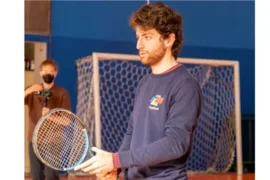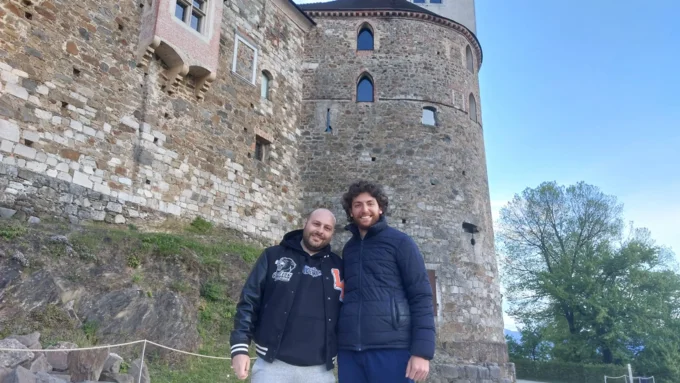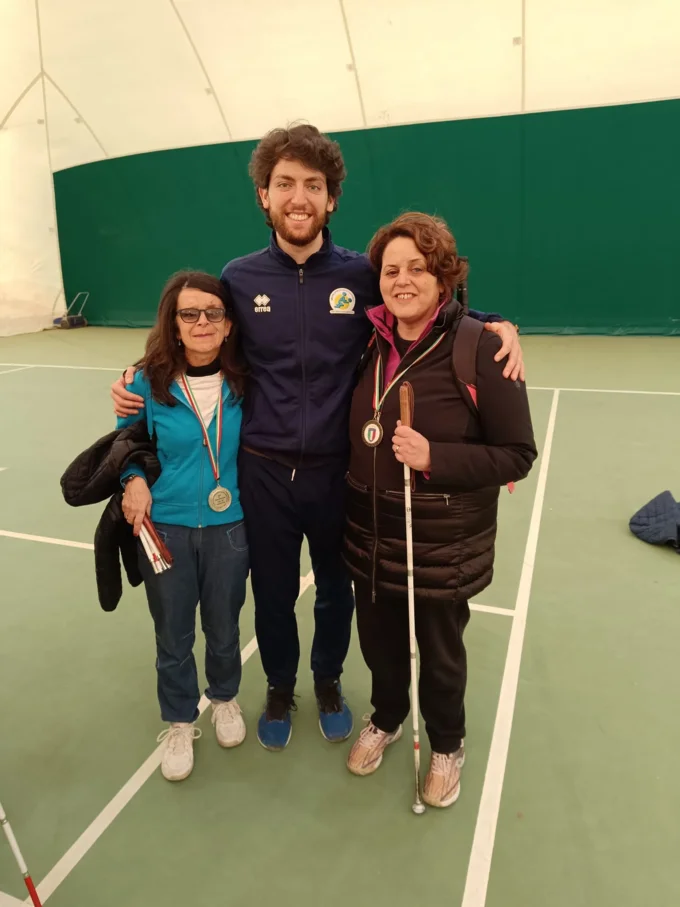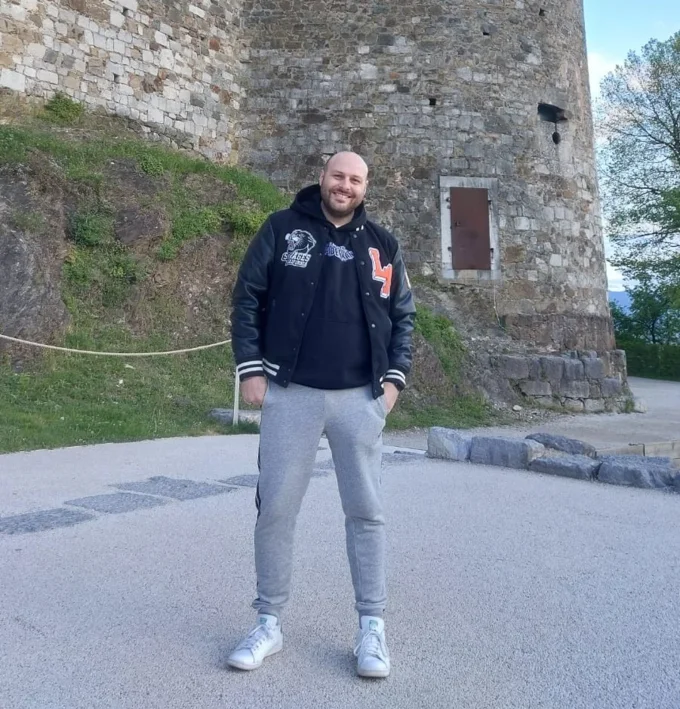What's up: Blind tennis - a sport over the horizon

In this month’s What’s up student Column our EUSA Italian Civil Service volunteer Mr Simone De Luca elaborates on the topic of Blind Tennis A Sport Over The Horizon.
It’s my great honour and pleasure to have the opportunity to write about the job of a dear friend who has turned his passion into a full-time job, dedicating himself to his personal growth and to the expansion of a sport that is still not so known. I decided to write an article about this practice so that people as my Italian friend could have the opportunity to share their story and raise awareness about a sport that is becoming more popular and important year by year. Today I have the pleasure to share the story of Simone Verre, a coach of blind tennis who gave me the opportunity to share this story with an interview that I will giving here question by question.
Who are you, why do you do this job?
Hello everybody! My name is Simone Verre and I’m a 27-year-old Italian who lives and works in Milan. I teach tennis for 4 years and blind tennis for 3 years. Tennis has always been a part of my life. I started playing tennis when I was six years old and it was love at first sight. From then I played constantly and I started my first training sessions in Qatar, being par of an amazing experience for the Doha tournament which takes place every year there. I was also a ball boy, and I was able to see different famous players, with this my passion grew even more. I still follow the tournaments almost every day and my passion about tennis in all its forms still give me a lot of satisfactions.

Why blind tennis, what motivated you to specialise in this field?
The opportunity to take Blind Tennis courses came in April 2021 when the company I still train for, called “Playmore!”, gave me the chance to follow Blind Tennis courses. For the first time I was surprised that blind and visually impaired people could play, a positive shock that gave me the chance to take an interest in this course and follow into it with more curiosity. This opened new possibilities such as being able to travel quite regularly to tournaments and competitions, both national and international. I took part in different tournaments like in Sopot and Krakow in Poland. In these competitions, beautiful team groups were created and new theories were applied to win the tournaments, dynamics that impressed me immediately and that involved myself personally. I felt that I grew up a lot as man and person, a touching experience that gives you a lot of satisfaction on a human level.
What motivated me to specialise in this field was the challenge of the sport itself, being able to teach people with visual limitations was very stimulating for me. In the beginning I realised how what I learnt before was basically useless, how all that guidelines on vision were unsuitable in that situation. So, it was a Copernican revolution for me initially. Due to my strong inclination to learn, I immediately felt involved, and I appreciated the way I worked with my players, I felt motivated by the positive effects of my lessons. There are people with extraordinary experiences, for example one of my players was a Paralympic champion in Turin in 2006. Honestly it’s always good for me to see them give their best, even when new exercises are proposed, there is always enthusiasm, the research for constant feedback obviously has its usefulness. What pushed me most to continue this path is based on two aspects, the first is the human aspect and the second is the technical one. I really enjoy follow my players and being able to always learn from them and being able to teach them something technically new (on the court).

What is blind tennis and how does it work?
Blind tennis is an adapted version of traditional tennis for the blind and visually impaired people, the visually impaired people are persons who have minimal residual vision but unlike the blind people they can see, and they have a different adapted version of the sport in question. Blind tennis was invented by a blind student from Japan in 1984 called Miyoshi Takei who wanted to play tennis with his friends, to solve the problem he invented this discipline. As far as the sport itself is concerned, there are four or five categories. In the first category, called B1, blind and visually impaired athletes are grouped together and when they compete, the athletes wear masks in order to level out the substantial differences between a player who is able to distinguish lights and shades from another who does not have this possibility, then we have other categories like: B2,B3,B4 and in some cases B5 (but this is very rare) where only visually impaired athletes play, they are divided into categories according to their residual vision. The court for category B1 players is half the size of a regulation tennis court, at the bottom of the court there are tactile lines that the players use to position themselves.
They have a limit of 3 rebounds, currently they use sponge balls a bit bigger than the classical balls with probes in them, these balls emit a sound that can arise them when the ball hits the ground or the racket. The players use slightly smaller rackets (halfway between adult and children's rackets, 23 or 25 inches). The category B1 has 3 rebounds available, category B2 has 3 rebounds available, category B3 has 2 rebounds available and category B4 has one rebound available. The other substantial difference is that the court of the visually impaired people is larger than the one of the blind people and there are no tactile lines because they have residual vision and can orient themselves. The size of the visually impaired court is slightly shorter than the normal field, so there is not so much difference. I would like to show you some statistics but unfortunately we do not have many data about Blind tennis like number of athletes in Italy or abroad.

What do you think are the obstacles, challenges, limitations?
Blind tennis is still a very sectoral sport, but the main challenge now is to involve as many people as possible with visual impairments, because most of the people are afraid to get involved, afraid to leave the house and be stigmatised, afraid to confront with something new, especially the youngest who suffer the most. Blind and visually impaired people also play to oppose this feeling of pity that other people can feel for them. According to my experience there is nothing wrong using the verb “see” because there is nothing offensive about it. What these people appreciate most is the fact that they are treated as persons. You have to be calibrated, but once you get into the mechanism of the group the best part is also to joke about everything without of course deliberately offend. This is also the stigma that we would like to fight (excessive respectability).
To give an example, a 20-year-old boy come for the first time to join his first lesson and from there he wanted to sign up and do a subscription with me because I shared with him the passion for this sport. I felt so proud because we got a young boy motivated, we found a solution together on the field and we managed to make him feel part of the group. The actual challenge is to make sure that so many more young people hear about blind tennis and get interested, we must raise awareness. The future dream is that (one day) blind tennis will be recognized as a total Paralympic sport and (one day) I will see my athletes play in the Paralympics. The sport is developing more and more, even if there are still some things to be defined, such as the teaching methodology and the scheduling of stable and regular tournaments. Of course, we are talking about a sport that still is a very sectoral reality, nothing to compare with, for example, blind football. However, blind tennis is establishing itself more and more in international level. This is a world where everyone knows each other well due to the still limited presence of athletes and coaches. In the future we hope that there will be many more people and in the same way an increase in competition in technical/tactical level as a result. In addition, these tournaments are a fantastic time of recollection where you can always innovate for example in one tournament, I had the opportunity to see Pakistani number 1 player in the world who played all the matches with knee pads. Thanks to him, I was able to invent a way to teach new styles and techniques of play. One big challenge on the blind tennis court is to find a way to increase the exchanges (serve/serve-response) try to improve the exchanges over 3 strokes.

What could we do to raise awareness and promote the sport both today and in the future?
In Italy is developing in some regions such as: Lombardy, Sardinia, Sicily, Friuli (where this year the world championship will be held in Lignano Sabbiadoro )and even in Bologna there are excellent players. Currently abroad they are doing a very good job at the level of involvement such as in Australia or in the USA, also in Japan there is an established tradition (because of origins), in Argentina, in Germany, in Spain, in Ireland and there are more and more countries where blind tennis is spreading, and this is very encouraging. Promotion through social channels or traditional one means to reach as many people as possible, there are also awareness projects in schools or companies, use blind tennis as a team building vehicle (my idea), these projects have already been done with great results. Obviously, the challenge remains to involve as many people as possible, including young people, also because it is not easy for them to leave home. Nowadays, it is possible to get these people to play sport, so we must work in this direction also because (trust me) is really satisfying to see the results on people “skin”.

At the end of this interview, I think it is very interesting to underline again the main points that Simone emphasized, the road of the blind tennis is still long and difficult. I personally think that stories like this can be an opportunity for everyone not only to know a new sport and a new environment in general but also to take advantage of these opportunities to better understand ourselves. What we can do to improve our relationship with blind people and could think about a project that can open something new for everyone, a new horizon beyond social barriers. I want to say thank you to Simone that has been available, open and super kind to share with me his story.
The author of this article, Simone De Luca, has an academic background in political science and international relations. He is currently a volunteer at the European University Sports Association as part of the Italian Universal Civil Service Program.

Are you a student with an opinion? We are looking for new contributors for our student column every month. Feel free to contact stc@eusa.eu to offer a piece or propose a topic.
